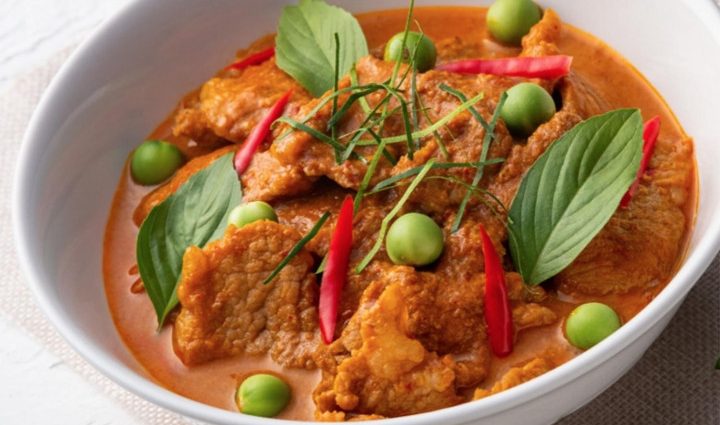
The inclusion of phanaeng curry at the top of the list of the “100 Best-Rated Stews in the World” provides food vendors and the tourism industry with optimism in the hope this will attract more tourists.
TasteAtlas, a global food mapping site for local dishes, named phanaeng curry the best curry in the world on March 13, drawing much public and press attention.
According to TasteAtlas, the dish is one of many Thai curries distinguished by its thick texture derived from salty-sweet peanut sauce.
Meat, dried chilli, kaffir lime leaves, coconut milk, cilantro, cumin, garlic, lemongrass and shallots are also common ingredients in the thick coconut cream-based phanaeng curry, which is traditionally served without vegetables but with rice.
Legions of enthusiasts
Krittiya Kanphuthon, 54, a food vendor in Pathum Thani, said it is great to hear that Thai cuisine is ranked so highly.
The curry is favoured by both the locals and people from elsewhere, similar to massaman curry, which is also highly regarded by food critics. “Both types of curry are popular with tourists who visit my shop,” with massaman curry being slightly more popular, she said.
“This could be because kaeng phanaeng is often spicier, and massaman may be more suited for Western tastes,” while both curries dishes are equally popular among Chinese and Taiwanese tourists, she said.
The government could provide more information by promoting a list of must-try Thai foods at hotels in tourism hotspots, she said.
Likewise, another food shop owner, Saijai Muakchaiya, 60, said phanaeng is a popular item in her shop.
Ms Saijai said it is a favourite among both Thais and tourists.
The listing was unlikely to benefit her much because her shop is not in a tourist spot. However, but it might benefit those selling the curry in tourist hotspots such as Phuket and Pattaya.
“The food is widely available, so people will eat where it is convenient for them,” she said.
Paitoon Sommat, 42, a restaurant owner in Bangkok, said: “I believe it deserves to be number one because it is so tasty.”
He said his main customers are Thai, but according to food vendors in tourism areas, phanaeng sells particularly well to foreigners.
“I believe that good news like this could attract more tourists because they may want to try new food,” he said, adding the government should take advantage of this opportunity to spread the word through the media.
Kanisorn Boonareesirichai, 16, a high school student and phanaeng enthusiast, said she was delighted with the news.
Health benefits
While the food is delicious, phanaeng also has health benefits though it comes with a warning label. According to Bungern Thongmon, a specialist nutritionist at the Ministry of Public Health’s Bureau of Nutrition, phanaeng is high in calories.
“It has pork and coconut milk after all,” she said, adding that 100 grammes of the curry, about a small cup, will yield about 160 calories, and combined with two scoops of rice will add another 160 calories, for a total of 320 calories.
In reality, people eat much more than this, resulting in even more calories.
While coconut milk adds thickness, richness, oiliness and sweetness to dishes, it also contains saturated fat, which adds to the calorie count.
However, there are some benefits, such as lauric acid, which can prevent pathogens and inflammation and boost immunity.
She said coconut meat contains a variety of vitamins, while the spices in phanaeng curry, such as galangal, lemongrass and shallots, are also herbs that can help reduce flatulence.
“However, my main concern is that pork has high cholesterol levels,” said Ms Bungern, so one of her recommendations is to avoid pork phanaeng and instead opt for chicken.
She recommends eating phanaeng with fresh and clean vegetables to provide more nutrients and also help round out the meal.
If consumers feel full, they won’t need to eat anything else.
The recommended serving size is approximately one small cup of curry and two scoops of rice, with at least two scoops of fresh vegetables.

